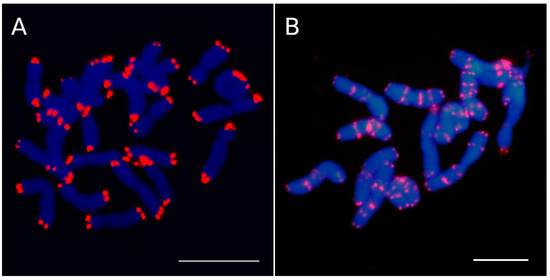Plant Telomere Distribution Analysis
The ends of linear eukaryotic chromosomes are protected by the telomere, a specialized nucleoprotein complex. The primary role of the telomere is to protect the chromosome ends from being degraded or recognized and processed as double-strand breaks. Understanding the distribution patterns of plant telomeres can provide valuable insights into various biological processes, including chromosome organization, replication, and cell differentiation.
The distribution patterns of plant telomeres exhibit intriguing variations among different chromosomes and cell types. Lifeasible's advanced technologies for telomere distribution analysis offer valuable insights into these patterns, advancing our understanding of plant biology.
Techniques for Analyzing Telomere Distribution
- Telomere fluorescence in situ hybridization (FISH)
We utilize this technique, which involves fluorescent probes that bind to telomeric DNA sequences. Telomere length and distribution can be determined by measuring the fluorescence intensity along the chromosomes. FISH can be combined with other DNA staining methods to visualize telomere localization within the nucleus.
- Telomere restriction fragment (TRF) analysis
We perform TRF analysis, which involves digesting genomic DNA with restriction enzymes that do not cut within the telomeric repeats, followed by Southern blotting and hybridization with telomere-specific probes. The resulting fragment pattern can be visualized and compared to determine telomere length and distribution.
Plant Telomere Distribution Patterns of Different Chromosomes
 Fig. 1 Distribution of telomere sequences on chromosomes in different plants. (Maravilla AJ, et al., 2021)
Fig. 1 Distribution of telomere sequences on chromosomes in different plants. (Maravilla AJ, et al., 2021)
- Telomere distribution can vary across different chromosomes in plants. Studies have revealed that certain chromosomes may possess distinct telomere organization and behavior compared to others.
- We provide analysis services of plant telomere distribution patterns of different chromosomes. In certain cases, telomeres tend to cluster in specific regions, such as near the centromeres or telomeric regions. This clustering can have functional implications, as it may facilitate proper chromosome organization and ensure accurate transmission of genetic information during cell division.
Plant Telomere Distribution Patterns of Different Cell Types
- In addition to variations in telomere distribution across chromosomes, different cell types within a plant organism can exhibit distinct telomere distribution patterns. This phenomenon can be observed during tissue differentiation and development.
- We offer analysis service of plant telomere distribution patterns of different cell types. For example, in some cell types, telomeres may become localized to specific subnuclear compartments, such as the nucleolus or the nuclear periphery. This positioning can be associated with specific functions or regulatory mechanisms in these cells.
- Understanding the distribution of telomeres in different cell types is crucial for unraveling the mechanisms underlying cell differentiation and development in plants. By studying telomere distribution patterns, researchers can gain insights into how chromosomal dynamics and gene expression are regulated during plant growth and regeneration.
At Lifeasible, our team of experienced scientists and technicians has over years of expertise in the field, ensuring accurate and reliable results. If you are interested in our services or have some questions, please feel free to contact us or make an online inquiry.
Reference
- Maravilla AJ, et al. (2021). "Interstitial Telomeric-like Repeats (ITR) in Seed Plants as Assessed by Molecular Cytogenetic Techniques: A Review." Plants (Basel). 10 (11), 2541.
For research or industrial raw materials, not for personal medical use!
 Fig. 1 Distribution of telomere sequences on chromosomes in different plants. (Maravilla AJ, et al., 2021)
Fig. 1 Distribution of telomere sequences on chromosomes in different plants. (Maravilla AJ, et al., 2021)